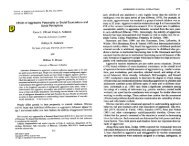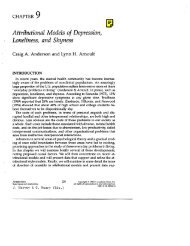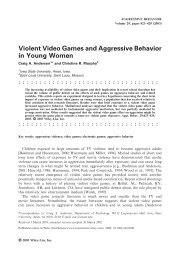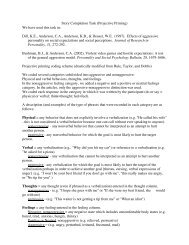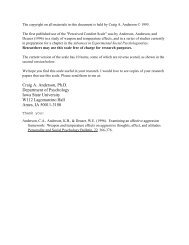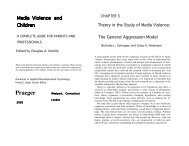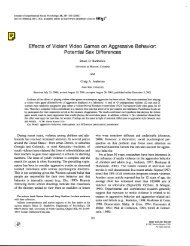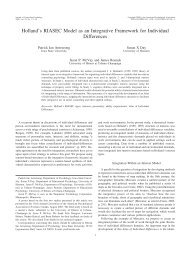The Effects of Violent Music on Children and Adolescents
The Effects of Violent Music on Children and Adolescents
The Effects of Violent Music on Children and Adolescents
Create successful ePaper yourself
Turn your PDF publications into a flip-book with our unique Google optimized e-Paper software.
Name /mea_gentil_106027/106027_08/Mp_162 10/16/2003 02:46PM Plate # 0 pg 162 # 10<br />
162 Media Violence <strong>and</strong> <strong>Children</strong><br />
that is, <str<strong>on</strong>g>of</str<strong>on</strong>g> a c<strong>on</strong>stellati<strong>on</strong> <str<strong>on</strong>g>of</str<strong>on</strong>g> related traits with heavy metal as the focal point?<br />
Probably not. If there is a “syndrome” at work here, it is a “troubled youth<br />
syndrome,” not a heavy metal syndrome. Leaving aside for now the questi<strong>on</strong><br />
<str<strong>on</strong>g>of</str<strong>on</strong>g> whether popular music exercises any influence <strong>on</strong> adolescents’ values <strong>and</strong><br />
behavior, assuredly the c<strong>on</strong>sumpti<strong>on</strong> <str<strong>on</strong>g>of</str<strong>on</strong>g> heavy metal is not what brings together<br />
the various “at-risk” characteristics with which heavy metal f<strong>and</strong>om is<br />
associated. <str<strong>on</strong>g>The</str<strong>on</strong>g> best way to phrase the relati<strong>on</strong> is to say that white adolescents<br />
who are troubled or at risk gravitate str<strong>on</strong>gly toward the style <str<strong>on</strong>g>of</str<strong>on</strong>g> music that<br />
provides the most support for their view <str<strong>on</strong>g>of</str<strong>on</strong>g> the world <strong>and</strong> meets their particular<br />
needs: namely, heavy metal.<br />
<str<strong>on</strong>g>The</str<strong>on</strong>g> point can be further clarified, perhaps, by juxtaposing these statements:<br />
(1) Most heavy metal fans are not particularly troubled or at risk, but (a) those<br />
youths who are troubled or at risk tend overwhelmingly to embrace heavy<br />
metal. In other words, whatever percentage <strong>on</strong>e uses to estimate the proporti<strong>on</strong><br />
<str<strong>on</strong>g>of</str<strong>on</strong>g> heavy metal fans in the total adolescent populati<strong>on</strong>, they surely number<br />
in the tens <str<strong>on</strong>g>of</str<strong>on</strong>g> milli<strong>on</strong>s. Most <str<strong>on</strong>g>of</str<strong>on</strong>g> these young people are not <strong>on</strong> drugs, not in<br />
jail, not failing in school, not depressed, perhaps not even particularly at odds<br />
with their parents (except maybe when it comes to music). Arguing the other<br />
way, however, if we know a youth is white, male, 15 years old, drug involved,<br />
<strong>and</strong> in trouble with the law, then the odds are veryhigh indeed that his music<br />
<str<strong>on</strong>g>of</str<strong>on</strong>g> choice will be some form <str<strong>on</strong>g>of</str<strong>on</strong>g> hard rock or heavy metal.<br />
Our rejecti<strong>on</strong> <str<strong>on</strong>g>of</str<strong>on</strong>g> the idea <str<strong>on</strong>g>of</str<strong>on</strong>g> a true heavy metal syndrome should not be<br />
taken to imply that heavy metal music plays <strong>on</strong>ly a peripheral role in the lives<br />
<str<strong>on</strong>g>of</str<strong>on</strong>g> its devotees. Heavy metal fans are an especially committed, devoted audience.<br />
Those who love the genre are highly absorbed in their musical identity,<br />
in terms <str<strong>on</strong>g>of</str<strong>on</strong>g> both listening time (Wass, Miller, & Stevens<strong>on</strong>, 1989) <strong>and</strong> a variety<br />
<str<strong>on</strong>g>of</str<strong>on</strong>g> other music-related behavior. Arnett (1991a) reports that high school students<br />
describing themselves as “metalheads” spent more than twice as much<br />
m<strong>on</strong>ey <strong>on</strong> albums, c<strong>on</strong>certs, <strong>and</strong> music equipment as a comparis<strong>on</strong> group <str<strong>on</strong>g>of</str<strong>on</strong>g><br />
n<strong>on</strong>metal fans. <str<strong>on</strong>g>The</str<strong>on</strong>g>y also tended to express very high levels <str<strong>on</strong>g>of</str<strong>on</strong>g> pers<strong>on</strong>al identificati<strong>on</strong><br />
with their favorite performers, were more likely to say lyrics are<br />
important to them, claimed a deeper underst<strong>and</strong>ing <str<strong>on</strong>g>of</str<strong>on</strong>g> lyrics, <strong>and</strong> were more<br />
likely than other youth to adopt their favorite musicians as role models. As<br />
Arnett points out, heavy metal plays a crucial role in the lives <str<strong>on</strong>g>of</str<strong>on</strong>g> the alienated<br />
<strong>and</strong> disaffected youths who seek it out; for many such youths, listening to<br />
heavy metal is what matters to them most. As has been noted in other chapters<br />
in this volume, the questi<strong>on</strong> <str<strong>on</strong>g>of</str<strong>on</strong>g> “initial causality” is probably not the important<br />
questi<strong>on</strong>. That is, whether heavy metal music is the thing that starts children<br />
becoming more troubled, or whether alienated youth start to like heavy metal<br />
(which is what research suggests), is probably not the best questi<strong>on</strong> to ask. A<br />
better questi<strong>on</strong> might be how will music with antisocial themes affect children<br />
who are already at risk for antisocial behaviors? It does not matter whether<br />
music started the cycle; it matters that the themes encountered in the music<br />
may help to perpetuate it. That is, the music may reinforce aggressive <strong>and</strong>



